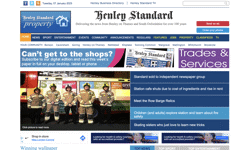“You probably have things in your refrigerator that are older than this business,” Hearst Magazines president David Carey reminded media types at a Bloomberg summit this spring. “It’s still early and the business models are still being formed.”
Indeed, the latest drumbeats bring indicators that initial expectations are being throttled back, at least in some quarters. Case in point: Condé Nast - which already has iPad editions of Wired, GQ, Vanity Fair, The New Yorker, Glamour, Golf Digest, Self and Allure and has many branded app offerings outside of magazine issue content - has now decided to assess reader scalability and advertising support before proceeding with launching iPad editions for more titles.
“The official stance was, we’re going to get all our magazines on the iPad because this is going to be such an important stream,” an unnamed Condé publisher told Advertising Age. “The new change is maybe we can slow it down. In my opinion, it makes Condé look smart because we have the ambition, but we’re not rushing. They’re not all doing all that well, so why rush to get them all on there?”
Condé Nast president Bob Sauerberg assured Ad Age that there’s been no “fundamental shift” in the company’s commitment or enthusiasm regarding apps. “Given our industry lead, with digital editions from eight of our titles on the iPad and more on the way, in addition to a good deal of learning under our belt, we are increasing our focus on distribution and sales efforts that will encourage scale,” he explained.
This report comes after pricing and promotion moves accompanying Condé’s decision to migrate all of its apps (including GQ, Vanity Fair and Glamour) to the Adobe platform already used by Wired and some other titles. In doing so, it eliminated pricing discounts for repeat app purchasers, meaning users are now generally paying the same prices as for print newsstand copies.
Given general US newsstand trends, Condé’s move to “re-examine” app pricing (head off newsstand cannibalism) would certainly seem sensible, even if it alienates more than a few app users. But there’s more to the picture. Wired, not surprisingly given its tech reader base, is among the most successful magazine iPad apps, but it’s now seeing about 20,000 to 30,000 paid downloads per month versus the 100,000 for its first issue a year ago.
Effects of the Apple stalemate
All Things Digital blogger Peter Kafka is not alone in suggesting that the continuing stalemate with Apple that’s kept Condé and most other major publishers from offering iPad subscriptions is limiting circulation and thereby impeding hoped-for levels of advertising support. Wired reports having more advertising now than initially, but other publishers report otherwise.
And as the UK’s New Media Age reported, many major brands are holding back from magazine app advertising because of inadequate download reporting metrics, high production costs and their estimation that these apps are priced too high. And while some brands are buying goodwill with sponsorships that let consumers bypass paywalls for popular publication apps, this spurs trials but ultimately undermines weaning readers off free digital content.
Also, as of late April, the major publisher consortium’s Next Issue Media newsstand platform (originally slated for Q1) had yet to launch.
Still, it would be unfair and inaccurate to focus only on the obstacles and hitches at this early stage of the game. Bonnier, which did accede to Apple’s sub terms, sold 100,000 Popular Science iPad subs within the first six weeks. Meredith - taking its time to conduct extensive consumer research - launched iPad editions of Better Homes and Gardens, Parents and Fitness in March, having determined that iPad usage among its huge readership base of adult women had reached sufficient levels to ensure viably large audiences for these products.
And Hearst Magazines - despite holding out against Apple’s sub terms along with Meredith, Time Inc and Condé - has projected that electronic formats will grow to account for 25% to 30% of its total circulation within five years. Apple, important as it is, is not the only option: Google’s app sub terms are much more amenable to publishers (no data access issues and a 10% take of sales versus Apple’s 30%), and Amazon’s store for Android apps holds significant promise, to name just two developments.
Hearst is hardly alone in articulating a “360-degree,” all-platform strategy for its brands, but it currently appears to be the most aggressive in realising this mission. For starters, its model embraces not just full-blown interactive apps, but simpler versions made for straightforward reading off tablets - and a range of subscription term and pricing options reflecting versions tailored to varying user needs.
Further, Hearst continues to: form partnerships to launch e-commerce and gaming ventures, even as it prepares to absorb all of Lagardère’s magazine brand assets outside of France; follow the model of its highly successful Food Network Magazine by launching a lifestyle print magazine with the HGTV cable network; and work with reality TV maven Mark Burnett and TV / film producer Mosaic to create magazine-branded mass entertainment properties.
In short, while very much on the app case, Hearst is also “bullish” on the future of print magazines (particularly in non-US markets) and views all available platforms / media as synergistic brand exposure and cross-promotional opportunities that will build paid purchases of content and services (and advertising revenue) across the full spectrum. Given that magazine apps’ greatest long-term challenge of all is marketing - being noticed amid the multitude of continually expanding options out there - this strategy seems to bode well for that platform, as well as the company as a whole.










